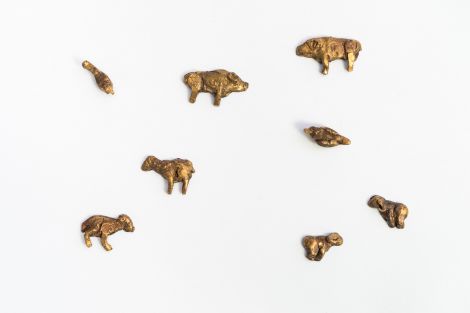These artworks are representative of Fine Art student William Langridge’s study at the Queensland College of Art and Design over 2019/2020.
His work spans jewellery and small object making, studio drawing, craft and woodworking and he often explores themes of religion, identity, and myth.
William cites QCAD faculty, Elizabeth Shaw, Claire Poppi, Matthew Neale, Bill Platz, Kelly O'Dempsey and Jenny Burgess as influences.
“For me, learning how to make or do something is as much a part of the process as creating art is. This means I make drawings on paper and in sheet metal, as well small sculpture and wearable objects. It’s a little bit like finding a way to stop time, or manifesting a piece of knowledge in front of you. I will often use Christian imagery and symbols in my work because as a Christian they fascinate me. We all keep information and different histories and skills alive in some way shape or form; I just like trying to make them fit onto a sheet of paper.”
Image (right) William Langridge working in his home studio. Photograph by Louis Lim.
#QCADatHome Q&A with Fine Art student William Langridge
QCAD at Home is a new open-call initiative that aims to explore what can be created beyond our gallery walls and studios. We invited our students and alumni to present what they are working on while at home. The project aims to bridge the current physical distances through making, sharing and connecting. Follow the #QCADatHome hashtag to see more.
- What inspired you to study a Bachelor of Fine Art at the Queensland College of Art and Design?
- My high school art teacher was a man named Andrew Peachey, who is a QCAD alumni. He both sang the praises of QCAD, and along with the other art teachers, really encouraged me to consider taking up the Bachelor of Fine Art. I thought that I would give it a crack, and I have loved it ever since I started.
- Your work involves very hands-on practices. What's your approach to human touch and tactility in both the materials you use and your process?
- I honestly believe that there is something of the divine in the act of making things with your hand. Physically putting that effort in, and creating something from raw materials gives such a payoff. As well, there is something quite special in knowing that you, here and now, are acting out the same steps that countless other people have throughout time.
- What makes Artisans so unique?
- Artisans walk a line between tradesman and artist. They hold a unique place because the often hold unique skills. They also carry history. The knifemakers and cobblers and tailors and furniture makers don’t just make and create new things, but keep alive old ones.
- While working at home during COVID-19, you started to create your own tools. Could you describe some of the processes behind this?
- I was initially prompted to start making tools, mainly because I didn’t have the ones I needed. A classmate joked that this period of isolation was the perfect practice for after graduation. I fell back onto woodworking skills I’d picked up as a teenager, and just started making simple mallets. Then I moved onto my grandfathers’ lathe and started making handles, egg mallets and shaping forms. It’s really just a combination of simple woodworking skills, and a lot of practice.
- Themes of identity, religion and belonging permeate through your practice. Could you speak more to this?
- I have always loved stories, and stories in one form or another are how we understand who we are. Religious themes in particular, come into my practice because I am a Christian. My identity and belonging are inexorably linked to that truth. Because of that I am fascinated by the way Biblical symbols and images are used. The raw history and depth theologically behind what they signified continues to amaze me. They are also the universal big questions everyone is trying to figure out. In some way, I use my art to help me understand what my answers are.














